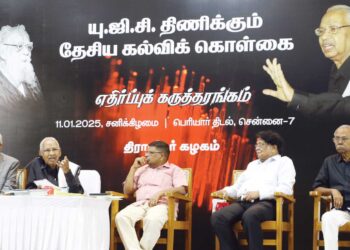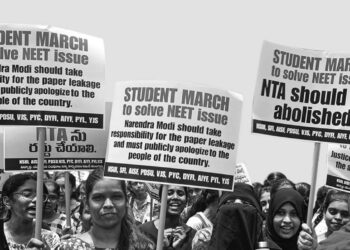In waving away cow protection as an appropriation by the wrong people, he Prime Minister refuse to recognise that the issue itself is embedded in communal imaginaries
Prof.Neera Chandhoke
national fellow
Indian Council of Social Science Research
It is too early to make reasoned evaluations of Narendra Modi’s career as the Prime Minister of India. But of one thing we are certain: Mr. Modi is a consummate politician. One of the qualities of a skilled politician is the ability to prevaricate and run verbal circles around current political predicaments. Accomplished politicians simply refuse to be pinned down; they manage to slide through difficult questions with some practised ease. It is precisely prevarication that characterises the Prime Minister’s speeches on the rare occasions that he interacts with the media.
The political and the personal
In a 2013 Reuters interview, Mr. Modi was asked to respond to the 2002 communal riots in Gujarat. His answer was in keeping with his consistent refusal to regret the macabre killings and sordid mutilations that marked the riot. He adroitly circumvented the deeply political character of communal violence, and sought refuge in the domain of personal emotions. “If someone else is driving a car and we’re sitting behind, even then if a puppy comes under the wheel, will it be painful or not? Of course it is,” he responded. Note that the personal is not the political, the personal remained the personal, and the political remained unaddressed. “India’s Narendra Modi,” stated a headline inThe Washington Post of July 12, 2013, “lets politics go to the dogs”. In a lighter vein, a number of observers wondered why Mr. Modi, who steers politics and economics single-handedly towards the precise goals he sets, was sitting in the back seat of the said car.
The same sort of equivocation characterise his comments on ‘cow vigilantes’who freely torture, whip and kill Muslim cattle traders, and Dalits whose hereditary occupation is the skinning of dead cattle. The Prime Minister termed such people “fake cow protectors”, as anti-social elements, and as people who bring the presumably noble act of cow protection into disrepute. This “gau rakshak” business, he said, makes him angry. Once again, his response to a deeply political act, that of serious violations of the constitutional right to dignity and bodily integrity, is phrased in terms of personal emotions. Mr. Modi is a man who has a flair for the political, and yet he skilfully dodges the political nature of crimes committed by ‘cow protectors’.
The question that should be asked and answered is: why are acts of intimidation, coercion, extortion, brutality and plain bullying clothed in the fig leaf of cow protection at this precise moment in political time? We do not have to go very far to look for an answer. The party in power at the Centre and in some States has put all its energies in selectively choosing and implementing one of the Directive Principles of State Policy on offer, Article 48, which enjoins the state to preserve and protect cattle. The project of saving the cow so ardently pursued by Hindutva cadres and Bharatiya Janata Party (BJP) leaders provides enough immunity to those who violate constitutional rights to life and dignity. BJP politicians openly issue fatwas condemning entire families, which just might have consumed beef, to corporeal punishment. Cow vigilantes sit in judgment on infringements of the project, lynch women, Muslims and Dalits, and string up ‘errant’ men on tree branches. And police forces that should be bringing vigilantism to book provide a shield for criminals.
The Prime Minister suggests that people who carry out these horrific acts are not genuine cow protectors. He is right. Recently a television news channel exposed the rank mercenary motives of criminals who assault truck drivers ferrying cattle in western India, threaten and extract protection money from owners of cattle, and profit monetarily by arbitrarily confiscating cows that belong to others. Whether fake or real, cow protection has become big business for many, and poses a serious threat to the lives and liberties of others.
History of cow politics
The issue, however, is not whether the so-called protectors are genuine or fake. The issue is that the agenda of cow protection has been, since the 1880s, embedded in communal imaginaries, positioning of non-Hindus as the other, and communal rioting between Hindus and Muslims. The history of movements for the protection of cows in India is a sordid one. It has nothing to do with religion. This history recounts two overlapping tales of cynical politics. The first tale is that of unifying a deeply divided and hierarchically ordered Hindu community under the banner of cow protection. Whether the so-called lower castes, who not only consume beef but are also fated to skin dead cows, bought into this upper-caste agenda is still a matter of debate among historians. But the project, fashioned by cultural entrepreneurs and innovators in late 19th century north India, succeeded in achieving the second objective, that of identifying and metaphorically crucifying Muslims as beef-eaters, and as killers of cattle particularly during the festival of Bakrid.
The cow protection movement told us one tale of unifying a caste-ridden society, and of expanding the constituency of right-wing politics to the countryside. The second tale relates to the different ways in which the constituency of Indians was divided and fragmented by the symbolic body of the holy cow. Expectedly, both tales constructed Muslims as the other. The process treaded a well-worn path: the collective self is invariably defined in opposition to a manufactured ‘enemy’ with whom there can be neither truck nor transaction.
The cow protection movement in the 1880s followed three sorts of strategies to achieve its twin objectives. One, a number of cow protection associations were set up throughout India. Swami Dayanand Saraswati, the founder of the Arya Samaj, travelled across the northern part of the country to establish gau rakshak societies. Two, he and his followers mobilised public opinion on the issue through distribution of pamphlets and speeches. Three, Arya Samajists collected thousands of signatures and attached them to petitions addressed to the colonial government. These petitions implored the Government of India to ban cow slaughter. The outcome of these efforts could be foretold. Leaders of the Muslim community reacted indignantly, and in 1893 a number of riots between Hindus and Muslims broke out in Bombay, Punjab, Uttar Pradesh, Bengal and other parts of north India right up to Rangoon, and right up to the middle of the 20th century.
Because cow protection had become a politically significant issue, it was taken up in the Constituent Assembly. A provision for the protection of cattle was incorporated in the Directive Principles of State Policy. In the 1960s, a major movement for banning of cow slaughter was conceptualised and authored by then Rashtriya Swayamsevak Sangh chief M.S. Golwalkar.
A divisive tool in essence
But for most of the time the subject, like other Directive Principles of State Policy, has erupted episodically onto the political agenda right up to the electoral campaign of Mr. Modi in 2014. In speech after speech our aspirant Prime Minister stressed the need to protect the cow.
It is a pity that the Prime Minister waves away horrific incidents connected with cows as an aberration, and as an appropriation by the wrong people. He refuses to recognise that the issue itself is embedded in communal imaginaries and electoral calculations, or that it destroys bonds of citizenship through cynical deployment of divisive agendas signifying who belongs and who does not. The entire history of riots since the last decades of the 19th century shows the link between the issue of protecting cows and that of identifying non-Hindus as people who do not belong.
Of course India must protect its cows as well as other animals. Can we do so under the rubric of animal rights instead of the hate-filled vocabulary of gau rakshaks? We must learn from history, otherwise we will find ourselves, as the philosopher-essayist George Santayana warned, repeating history. The reiteration of oneness and otherness via the symbolism of the holy cow may serve the Hindutva brigade, but for the rest of us these actions violate our constitutionally granted fundamental rights.
Courtesy : ‘The Hindu’ August 9, 2016









